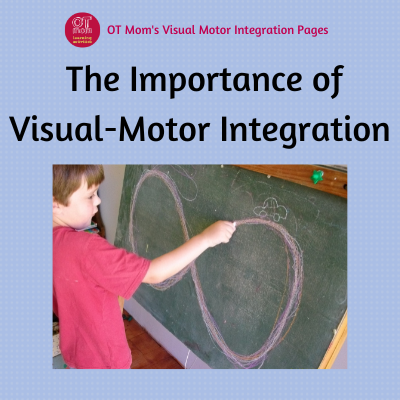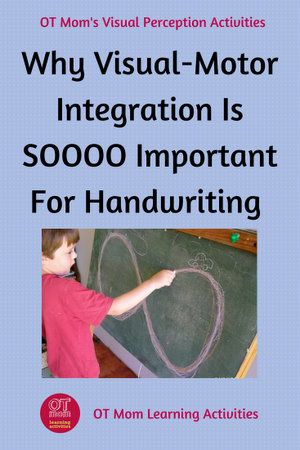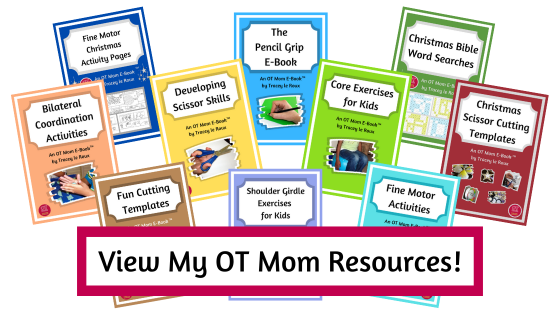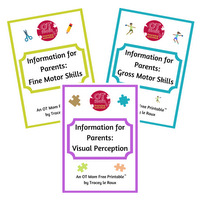- Home Page
- Visual Motor Integration
Visual Motor Integration
Visual Motor Integration (*) (often called VMI) involves effective, efficient communication between the information coming from your eyes and the information going to your hands, so that you are able to copy, draw or write what you see.
Kids who struggle with the integration of their visual systems and their motor systems may struggle with handwriting as well as with other school skills.
I sometimes link to products (#Ad) that are similar to those I use and love. If you do purchase something through my links, I will receive a small commission that helps support my site - thank you!
The Two Foundations Of Visual-Motor Integration
Effective coordination of the visual system and the motor system can only happen when there has been normal development of visual skills and motor skills.
The image below contains a breakdown of some of the skills needed in each system (base).
A delay in any of these areas may affect the integration of visual motor skills.
However, even if the child has developed good visual skills and good motor skills, VMI can still be poor, as it is the integration, or coordinated use, of the 2 bases that is important.
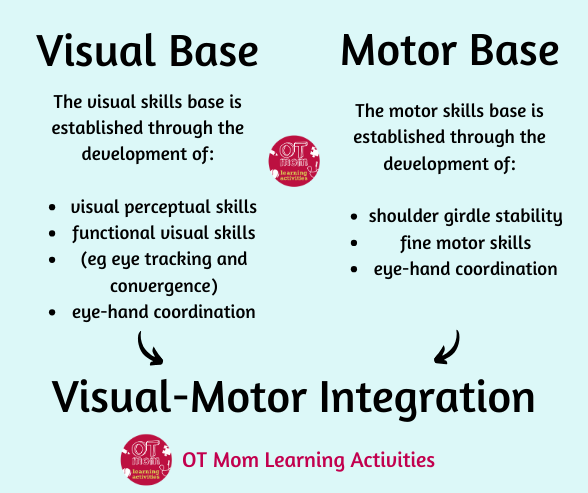 The integration of visual skills and motor skills
The integration of visual skills and motor skills(links to pages with more information on each of these skills are listed in the activity ideas and resources at the bottom of this page)
Are VMI and Eye-Hand Coordination the same thing?
Visual Motor Integration is more than simple eye-hand coordination, although there is a lot of overlap between the two skills.
Working on eye-hand coordination does help the visual and motor systems to work together, but there may be a subtle difference in the way they affect a child's written work.
Here is a brief description of the differences between the two.
In Brief: Eye-Hand Coordination
Eye hand coordination requires the eyes to visually guide the movement. It does not usually involve visual perception per se.
Examples of activities using eye-hand coordination:
- Hitting a ball with a bat
- Catching a ball
- Tracing a path between 2 lines
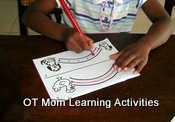 tracing a path between two lines
tracing a path between two linesWhat does poor eye-hand coordination look like at school?
- Children with poor eye-hand coordination may struggle to start and stop the pencil in the space given, and may miss or overshoot the lines.
However, fine motor delays can also affect a child’s eye-hand coordination during paper and pencil tasks.
In Brief: Visual-Motor Integration
VMI involves visual perceptual skills AND motor skills – the ability to correctly perceive a form in order to correctly replicate it.
Examples of visual-motor integration:
- correctly perceiving and copying shapes
- correctly perceiving and copying letters and numbers
What does poor visual-motor integration look like at school?
- Children with poor VMI often struggle to form letters well, and struggle to copy drawings.
- Younger children struggle to draw shapes and numbers.
- Patterns don’t flow, and numbers and letters may be written in a jerky stop-start way.
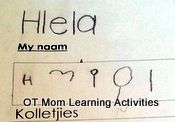 This 6 year old was unable to copy his name because of poor VMI.
This 6 year old was unable to copy his name because of poor VMI.Visual Motor Integration and Handwriting
Some studies have found VMI to be more important than either
fine motor skills alone or visual perceptual skills alone in determining
whether a child will have good handwriting (see References below).
Children need good visual-motor integration to be able to copy basic shapes (diagonal lines, circles, squares, triangles, intersecting lines) before they are able to learn to form their letters correctly.
- Visual motor integration delays may cause a child to struggle to copy numbers and letters correctly.
- The child’s handwriting may seem disjointed and lacking in flow.
- Handwriting may require lots of conscious effort, out of proportion to the task.
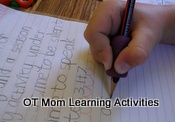 Poor visual-motor integration may affect handwriting
Poor visual-motor integration may affect handwritingIf you suspect a
VMI delay, a referral to an occupational therapist would be in order.
An OT would assess VMI skills (probably using the Beery or the DTVP-2)
and then administer a battery of other tests to see what factors are
hampering the child’s VMI skills. Getting to the root of the problem is essential!
Activity Ideas and Resources to Develop VMI
I have divided these activity ideas and resources into those that work on the visual base, those that work on the motor base, and those that work specifically on coordinating the visual AND motor skills.
Just follow the links to the free activity resource pages on my site and have fun with your child as you build their skills!
Please note that these activities are designed to promote your child's normal development and are not a substitute for therapy. If you are concerned about your child's skills, please contact an occupational therapist!
Free activities to work on visual perception skills - the "V" in VMI
- Visual discrimination tips and activities for kids
- Visual closure tips and activities for kids
- Figure-ground perception tips and activities
- Does your child need to work on functional visual skills with a behavioral optometrist?
Free activities to work on motor skills - the "M" in VMI
- hand strengthening exercises for kids
- hand and finger exercises to improve mobility and dexterity
- shoulder girdle exercises to improve stability
Free Activities That Help Integrate Visual and Motor Skills To Boost VMI
Although eye-hand coordination and visual motor integration have a somewhat different effect on your child's handwriting, as I described above, many eye-hand coordination exercises and activities can still help to improve your child's visual-motor skills.
I have thus included them in the selection below.
- Visual-motor integration activities to do at home
- Preschool visual motor activities
- Games and exercises for eye-hand coordination
- Scissor cutting activities - the hands and eyes need to work together to cut on the line
- Visual motor and drawing printable activities - ok, these are not free but they are super affordable and you can print and reuse them over and over again - I love these!
- Home Page
- Visual Motor Integration
- Home Page
- Handwriting for Kids
- Visual Motor Integration
Share this page to help others!
(*) Technically Speaking...
Visual-Motor Integration (with a hyphen between "visual" and "motor" is the technically correct way to write this term. Ditto for Eye-Hand Coordination.
However, more people search for these terms WITHOUT a hyphen between the words, so this article was written without the hyphen in order to reach and meet the needs of these searchers.
Professionals, please forgive this deliberate technical "error"!
References
1) Daly, C.J., Kelley, G.T., Krauss, A., “Relationship between visual-motor integration and handwriting skills of children in kindergarten: a modified replication study.” AJOT, 2003, 57(4):459-642. Abstract can be viewed here.
2) Relationship Between Visual-Motor Integration, Eye-Hand Coordination, and Quality of Handwriting by M-L Kaiser, J-M Albaret, and P-A Doudin, 2009. Read the article here.
Didn't find what you were looking for? Try a search of my site!
